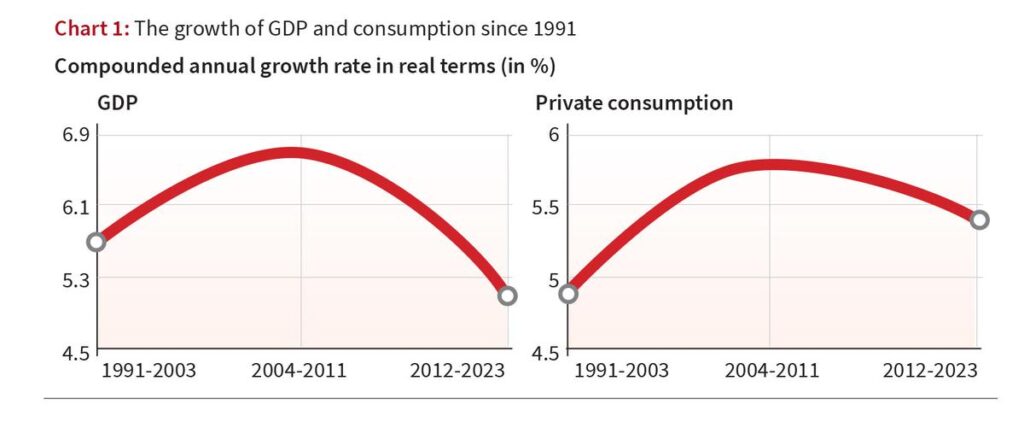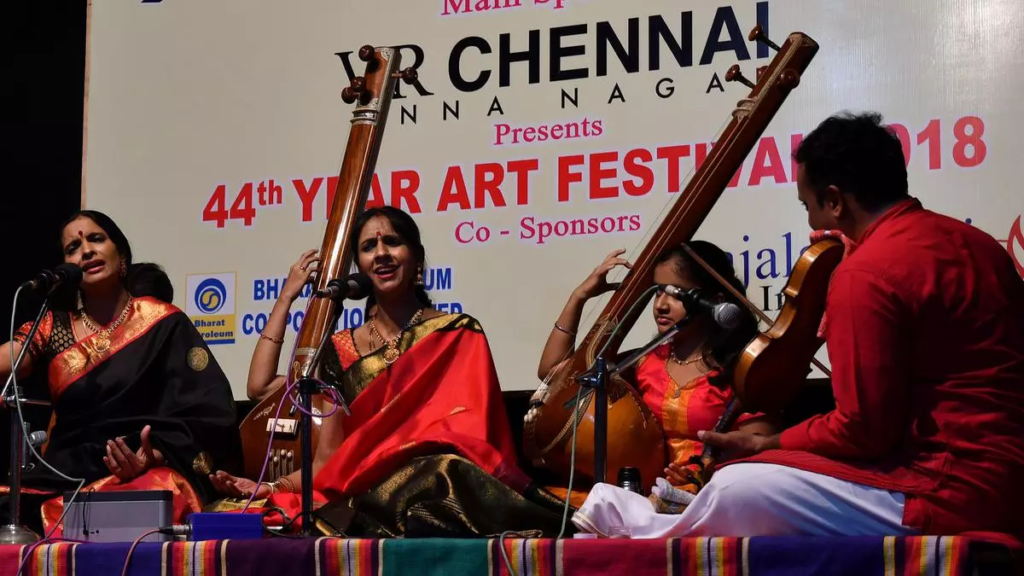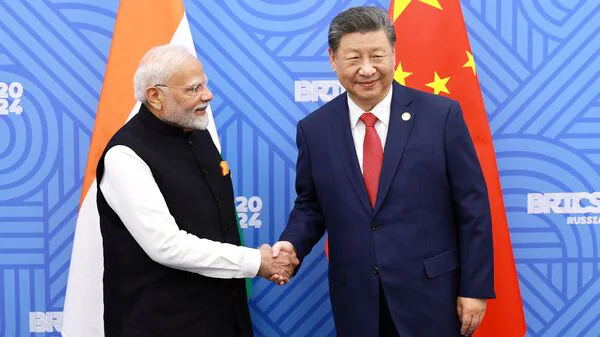How can the Budget arrest growth decline?
Source: The Hindu
Syllabus: GS II: Economy
Arresting Growth Decline: The Role of Fiscal Policy
Introduction
The Indian economy has been experiencing a slowdown, as reflected in recent GDP estimates. Despite rising capital expenditure in successive budgets, economic growth has remained below expectations. This raises critical questions about the effectiveness of fiscal policy in stimulating growth, particularly in the context of private consumption and investment. To address the current challenges, a historical analysis of economic trends is essential.
Understanding Growth Phases: A Historical Perspective
The post-reform period in India can be divided into three distinct phases:
- 1991-2004: A phase of liberalization-driven growth with rising income and wealth inequality.
- 2004-2011: A period marked by high growth alongside a significant reduction in absolute poverty.
- 2011-2023: A period characterized by economic shocks and sluggish private consumption and investment.
The period from 2004 to 2011 is particularly noteworthy as it witnessed a decline in the consumption share of the richest 20%, implying a faster rise in consumption among the bottom 80%. This unique trend highlights the role of fiscal policy in shaping demand patterns.

The Role of Fiscal Expenditure in Driving Growth
Growth is not solely dependent on the quantum of fiscal expenditure but also on its composition. Individuals at the lower end of the income spectrum exhibit a higher propensity to consume, meaning that public spending directed towards them generates a stronger multiplier effect on income and employment.
To illustrate this, consider two types of government expenditure:
- Capital Expenditure on Infrastructure (e.g., Dams, Nuclear Projects): While this can boost long-term growth, a substantial portion of such spending flows into profits and savings rather than immediate consumption. Moreover, capital-intensive projects often involve high import dependencies, reducing their impact on domestic demand.
- Revenue Expenditure on Welfare (e.g., NREGA Wages, Social Transfers): Since wages are directly spent on essential goods and services, such expenditure stimulates domestic demand more effectively, triggering a stronger multiplier effect across the economy.
Policy Lessons from 2004-2011
The economic boom of 2004-2011 coincided with increased state intervention through rights-based legislations (e.g., MGNREGA, Right to Education) and expansion in welfare schemes. Social sector spending witnessed a sharp rise, leading to:
- Increased rural wages, raising consumption demand.
- Higher employment generation, particularly in agriculture and rural sectors.
- A shift in income distribution, favoring the lower-income groups.
Current Challenges and Policy Response
Since 2012, and particularly post-2019, economic growth has slowed due to declining private consumption and investment. Major economic shocks—such as demonetization, the introduction of GST, and the COVID-19 pandemic—have exacerbated this trend. While the government has acknowledged the slowdown, its response has largely focused on capital expenditure, expecting it to crowd in private investment. However, empirical evidence suggests that investment is driven by demand rather than just cost incentives. In the absence of sufficient demand, tax cuts and increased capital spending have failed to stimulate private sector investment.
A Way Forward: Enhancing Revenue Expenditure
To revive growth, a dual strategy is required:
- Increase Fiscal Expenditure as a Share of GDP: This is essential to counter the slowdown and boost demand-driven growth.
- Rebalance the Composition of Spending: A shift towards revenue expenditure—particularly in the social sector—would create a virtuous cycle of rising income, employment, and private investment.
Additionally, capital expenditure should focus on labor-intensive projects with high domestic linkages to maximize its multiplier effect.
Conclusion
The experience of 2004-2011 underscores the significance of social sector spending in driving inclusive growth. As the government prepares its fiscal strategy, a crucial policy choice emerges: whether to prioritize fiscal prudence to appease markets or to undertake bold public expenditure measures to improve economic well-being. The upcoming Union Budget will be a key indicator of the government’s economic priorities and its commitment to reversing the current slowdown.
The copyright conundrum in Carnatic music
Source: The Hindu
Syllabus: GS I Art & Culture
The Copyright Conundrum in Carnatic Music: A Legal and Cultural Analysis
The Margazhi season in Chennai, a revered time for Carnatic music connoisseurs, is not just a celebration of classical heritage but also a stage for contemporary legal concerns—particularly those related to copyright. Traditionally, copyright law has not been a focal point in the Carnatic music sphere, primarily due to the widespread belief that it does not apply to this domain. However, this perspective warrants reconsideration.
Legal Framework and the Question of Musical Ownership
The jurisprudence surrounding copyright law in India has yet to clearly define what constitutes music. Justice V.R. Krishna Iyer, in Indian Performing Right Society Ltd. v. Eastern Indian Motion Pictures Association (1977), raised a fundamental question—does music pertain solely to composition, or does it encompass melody, voice, and rendition? This question remains unresolved in legislative discourse.
Global copyright frameworks define music primarily as a melody or composition that is reduced to print—a definition rooted in Western classical traditions. Indian copyright law, influenced by colonial-era legislations, has largely ignored the unique characteristics of Indian classical music, leading to legal ambiguities. This raises a critical question: should the law adapt to the realities of music, or should music conform to legal constraints?
Copyright Protection in the Context of Carnatic Music
A musical composition involves collaborative effort—of composers, lyricists, singers, and instrumentalists—each of whom enjoys distinct legal protections. While composers and lyricists hold rights over their works for their lifetime plus 60 years, performers have separate rights over their renditions. The ‘mechanical right’ allows a recording entity to commercially exploit a recording for 60 years. Performers’ rights, on the other hand, enable singers and accompanying artists to restrict unauthorized recordings and claim royalties for commercial use.
In practice, however, performers in Carnatic concerts rarely benefit from these protections. While prominent sabhas prohibit unauthorized recording, this is not a universal norm. Several performances are uploaded to platforms like YouTube and Spotify without due consent, constituting copyright violations that deprive artists of monetization opportunities. Even sabhas, if recording performances without the informed consent of performers, breach copyright laws.

The Public Domain and the Rights of Performers
Most Carnatic compositions belong to the public domain, as their creators—such as Tyagaraja, Muthuswami Dikshitar, and Purandara Dasa—lived before the advent of copyright laws. However, a crucial question arises: do a musician’s additions and improvisations to these compositions also enter the public domain, or should they be afforded independent copyright protection?
A Carnatic performer typically inherits their guru’s stylistic interpretation, blending it with their own creative improvisations. They may introduce variations in raga, tempo, or ornamentation, significantly altering the original composition. Notably, many compositions today are performed in ragas different from those originally envisioned by the composers. For instance, Gopala Krishna Bharathi’s compositions have undergone substantial melodic reinterpretations. Similarly, Bhimsen Joshi reintroduced Purandara Dasa’s works into Hindustani classical ragas, while Madurai Mani Iyer’s rendition of Eppo Varuvaro became a definitive interpretation. Do such unique contributions merit copyright protection? Current laws remain silent on this issue.
The Need for Legal Reform
Carnatic music thrives on spontaneity and audience engagement, making each performance inherently unique. Improvisations, whether in the form of swarakalpana, neraval, or raga explorations, often cannot be replicated identically. However, existing copyright laws fail to acknowledge these creative nuances, leaving artists without legal recognition for their interpretative contributions.
A reformative approach is necessary to address these gaps. Indian copyright law should:
- Recognize Performers’ Creativity: Grant performers copyright protection over their improvisations and unique interpretations of public domain compositions.
- Strengthen Royalty Rights: Ensure that artists receive equitable revenue from digital streaming and recordings of their performances.
- Regulate Unauthorized Dissemination: Implement stricter enforcement against the unauthorized recording and distribution of live performances.
Conclusion
At present, music in India follows the law, rather than the law evolving to safeguard musical heritage and artists’ rights. Carnatic musicians should have rightful ownership over their artistic contributions and the ability to commercially benefit from their performances. The legal framework must be updated to reflect the intricacies of Indian classical music and provide performers with the recognition they deserve. Addressing these issues is not just a legal necessity but also a cultural imperative, ensuring that India’s rich musical traditions continue to thrive in a digitally interconnected world.
Retinal diseases: RNA therapeutics show promise but is India ready?
Source: The Hindu
Syllabus: GS III Science & Technology
Retinal Diseases and RNA Therapeutics: The Path Ahead for India
Introduction
Vision plays a pivotal role in human life, enabling individuals to navigate their surroundings, engage in social interactions, and perform daily tasks. According to the World Health Organization (WHO), over 2.2 billion people worldwide experience some form of vision impairment, with causes ranging from cataracts and diabetic retinopathy to glaucoma and inherited retinal diseases (IRDs).
IRDs are genetic disorders that progressively lead to vision loss, often culminating in blindness. These conditions arise due to mutations in over 300 genes responsible for retinal function. Given India’s large and diverse population, the burden of IRDs is particularly significant, necessitating targeted therapeutic approaches.
The Burden of IRDs in India
Globally, an estimated 5.5 million people suffer from IRDs, with a prevalence rate of 1 in 3,450 individuals. However, studies indicate a much higher prevalence in India:
- 1 in 372 individuals in rural South India,
- 1 in 930 in urban South India,
- 1 in 750 in rural Central India.
Despite this alarming prevalence, India lacks large-scale cohort studies (with at least 500 patients) to map the genetic mutation spectrum of IRDs. Understanding these genetic variations is essential for developing effective precision medicine strategies.
Advances in Treatment: RNA-Based Therapeutics
A significant breakthrough in IRD treatment came in 2017 when the U.S. Food and Drug Administration (FDA) approved the first gene therapy for blindness caused by mutations in the RPE65 gene. This milestone paved the way for further gene therapy research, with over 50 ongoing clinical trials focusing on inherited eye disorders. However, gene therapy is not a universal solution, and RNA-based therapeutics have emerged as a promising alternative.
RNA-based therapies offer a targeted and safer approach to treating genetic disorders without altering DNA. Unlike genome-editing techniques, RNA therapies induce temporary changes, minimizing unintended long-term effects. Several RNA-based techniques are currently being explored:
- Antisense Oligonucleotides (ASOs): Already used in treating spinal muscular atrophy and Duchenne muscular dystrophy, ASOs are now being tested for retinal conditions such as Stargardt disease, Leber congenital amaurosis, and retinitis pigmentosa.
- RNA Editing with ADAR Enzymes: This technique corrects specific genetic mutations at the RNA level, restoring protein production in retinal cells without modifying DNA.
- Suppressor tRNAs: These molecules help bypass stop-codon mutations, which otherwise prematurely halt protein synthesis in retinal cells, potentially restoring retinal function.
- PTC124 (Ataluren): Initially developed for cystic fibrosis and Duchenne muscular dystrophy, this molecule is being investigated for treating aniridia, a rare developmental eye disorder.
These approaches collectively offer a more personalized and effective treatment strategy for IRDs, addressing the limitations of existing therapies.
Challenges in India’s Readiness for RNA Therapeutics
Despite advancements in RNA-based therapeutics, India faces several challenges in adopting these treatments:
- Lack of Genetic Research and Data: India has not yet conducted large-scale studies to map genetic mutations responsible for IRDs across diverse populations.
- Limited Awareness and Access: Clinicians and healthcare providers have limited awareness of available gene and RNA-based therapies, leading to underutilization.
- Scarcity of Genetic Counselling Services: Many patients do not receive adequate genetic counselling, which is crucial for early diagnosis and treatment planning.
- Insufficient Research Funding: Investment in genetic research and infrastructure remains inadequate, slowing progress in developing targeted therapies.
- Limited Diagnostic Facilities: Rural areas, in particular, lack access to advanced diagnostic tools needed to identify genetic mutations associated with IRDs.

The Way Forward
To fully harness the potential of RNA-based therapeutics in India, a multi-pronged approach is required:
- Enhancing Genetic Research: Large-scale cohort studies should be conducted to identify prevalent genetic mutations in the Indian population.
- Strengthening Collaborative Efforts: Partnerships between Indian research institutions, global pharmaceutical companies, and local healthcare providers should be expanded.
- Improving Clinical Awareness: Training programs and awareness campaigns should be initiated to educate clinicians about RNA-based treatments.
- Expanding Access to Genetic Counselling: Establishing more genetic counselling centers can facilitate early diagnosis and patient education.
- Investing in Infrastructure and Funding: The government must allocate dedicated funding for precision medicine and genetic research.
A notable example of successful collaboration is the June 2024 study by researchers from the CSIR-Institute of Genomics and Integrative Biology, New Delhi, and the L.V. Prasad Eye Institute, Hyderabad. Their research led to the development of a precision therapy for a specific form of IRD, highlighting the importance of targeted studies.
Conclusion
While RNA-based therapeutics hold immense potential for treating inherited retinal diseases, India must address critical gaps in genetic research, awareness, and healthcare infrastructure. By prioritizing investment in precision medicine and fostering collaborations, India can pave the way for accessible and effective treatments, ultimately improving vision-related healthcare outcomes for millions of patients.
India-China diplomatic thaw: what the fine print of their statements reveals
Source: The Indian Express
Syllabus: GS II International Relations
India-China Diplomatic Thaw: Resumption of Kailash Mansarovar Yatra, Direct Flights, and Trans-Border River Cooperation
Introduction
In a significant development towards stabilizing India-China relations, both countries have agreed to take key diplomatic steps, including the resumption of the Kailash Mansarovar Yatra, reinstatement of direct flights, issuance of visas for journalists and think tanks, and enhanced cooperation on trans-border river data sharing. These agreements follow a high-level meeting between India’s Foreign Secretary Vikram Misri and Chinese officials, reflecting a calibrated effort to restore bilateral engagement.
Diplomatic Narratives: India vs. China
India’s Perspective
India framed the discussions as a comprehensive review of bilateral ties, emphasizing the necessity of gradual, people-centric measures to rebuild confidence. The Indian statement underscored that these steps align with the agreements reached in previous high-level meetings, notably between Prime Minister Narendra Modi and President Xi Jinping in Kazan. The approach remains cautious, balancing engagement with the broader concerns related to border security and economic relations.
China’s Perspective
In contrast, China projected the meeting as a forward-looking initiative aimed at fostering improvement and development in bilateral relations. Beijing highlighted that both sides had reached a consensus on specific measures, portraying a more optimistic and strategic outlook on the engagement.
Key Agreements and Their Implications
1. Kailash Mansarovar Yatra
Both nations agreed to resume the sacred pilgrimage, but the framing of the timeline differed. While India stated that the Yatra would resume in the summer of 2025, subject to ongoing discussions on modalities, China exhibited greater urgency, asserting that the pilgrimage to the ‘Xizang Autonomous Region’ would resume ‘as soon as possible.’ The use of ‘Xizang’ (instead of Tibet) in China’s statement signals its strategic positioning on territorial nomenclature.
2. Resumption of Direct Flights
India and China reached an agreement in principle to reinstate direct flights, albeit with differences in emphasis. India underscored the need for technical negotiations and a new framework agreement, whereas China linked the restoration of flights to facilitating personnel exchanges, particularly for resident journalists. Before the suspension in 2020 due to the pandemic and the Galwan conflict, there were 539 direct flights per month, with a seat capacity exceeding 1.25 lakh. The current lack of reciprocal journalistic presence—India having only one resident journalist in China while China has none—was also highlighted.

3. Trans-Border River Cooperation
India and China agreed to convene an early meeting of the India-China Expert Level Mechanism to discuss hydrological data sharing and trans-border river cooperation. India has expressed concerns over China’s large-scale dam projects on the Brahmaputra (Yarlung Tsangpo), particularly the recently cleared super dam project. India’s statement emphasized the need for resuming hydrological data exchange and broader cooperation, while China focused on advancing dialogue and maintaining regular communication.
Strategic Analysis
India’s Approach: A Calibrated Step-by-Step Engagement
India’s position reflects a cautious and phased approach, prioritizing issue-based cooperation while keeping border security and economic concerns at the forefront. The Indian statement focused on reviving institutional dialogues and addressing mutual concerns through established diplomatic channels.
China’s Approach: A Strategic Long-Term Outlook
China maintained a broad, strategic perspective, advocating for stable and constructive bilateral ties. The emphasis was on enhancing exchanges, mutual trust, and avoiding ‘suspicion and estrangement.’ However, Beijing’s narrative largely downplayed existing border tensions and India’s trade-related concerns.
Unresolved Issues and Divergent Priorities
1. Economic and Trade Concerns
India raised concerns regarding market access and the need for policy transparency in economic engagements. However, the Chinese statement did not acknowledge these concerns, signaling a gap in trade-related discussions.
2. India’s Support for China’s SCO Presidency
China asserted that India had pledged full support for its presidency of the Shanghai Cooperation Organization (SCO) and would actively participate in its meetings. Notably, India’s official statement remained silent on this issue, reflecting possible reservations.
3. The Three Mutuals vs. China’s Call for Strategic Patience
China called for avoiding ‘mutual suspicion, estrangement, and exhaustion,’ while India has consistently articulated its foreign policy doctrine based on ‘mutual respect, mutual sensitivity, and mutual interests.’ These conceptual differences highlight contrasting perspectives on managing bilateral ties.
Conclusion
The latest India-China engagement marks an attempt to stabilize relations through people-to-people exchanges and functional cooperation. However, substantive divergences persist, particularly on border security, economic transparency, and strategic narratives. While the resumption of the Kailash Mansarovar Yatra, direct flights, and hydrological data-sharing mechanisms are positive steps, the overall trajectory of bilateral relations will depend on resolving deeper structural issues, including the lingering border disputes and economic asymmetries.